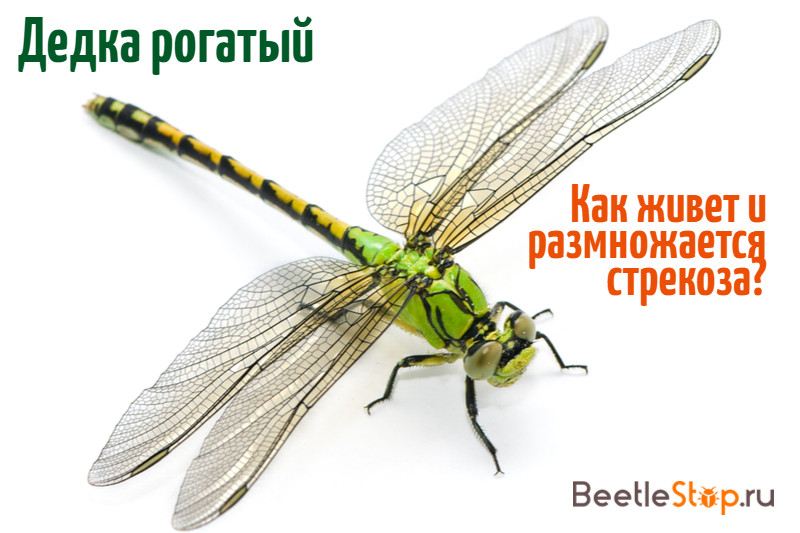Grandfather Horned or European River Dragonfly
The large family of grandfathers (Gomphidae) includes more than 900 species. Characteristic features of dragonflies are medium sizes and wide-set eyes. Insects live on all continents, excluding Antarctica. Near slowly flowing rivers and streams, you can see an olive-green dragonfly with black stripes on the abdomen. This is a grandfather horned. The name of the species was due to a small outgrowth on the back of the head. Violation of the hydrological regime of rivers leads to a reduction in grandfathers. They are included in the IUCN Red List, Red Books of Lithuania and Belarus.

Morphological description
Horned grandfather (Ophiogomphus cecilia) or common serpentine is one of the species of the grandfather family, the genus of the serpentine. Body length 50-56 mm, abdomen - 37-38 mm. Unlike other families, grandfathers have relatively short wings - 30-35 mm. The large head appears wider due to the eyes located on the sides. The gap between the convex faceted eyes is another difference from the rest of the representatives of the suborder of dragonflies. Three lower lip lobes of similar size. Weak antennae are almost invisible.
Information. A characteristic feature of the type of grandfather is horned - two small outgrowths on the back of the head.
The head and chest of the insect are colored green or yellow with black stripes and thin short hairs. Abdomen black with yellow oblong spots on each segment. The anal appendage of the male is divided into two parts, the small genital plate of the female is equipped with two outgrowths. The wings are transparent; males have a rounded notch at the base of the back pair. The hind wings differ from the front wings in shape and size, they are noticeably wider at the base. Dragonfly's hips are olive, on the legs there are light stripes, legs are black.
Habitat
The western part of the habitat is in the center of Europe, the eastern reaches Siberia and Lake Baikal. In Europe, the grandfather is horned in Austria, Finland, Sweden, Denmark, and Germany. It is registered in Ukraine, in Belarus and Russia (European regions) single finds. Dragonflies live in Central Asia, the Caucasus, the Urals.
Lifestyle features
Departure of adults begins in May-June and lasts until the end of the summer period. They are kept in coastal vegetation, shrubs. Dragonflies often fly 500-800 m from the coast. The flight is strong, but not swift, the number of maneuvers is limited. Horned grandfather spends a lot of time calmly sitting on plants. But the remoteness of the dragonflies is deceiving, at this time they carefully observe any movements. Noticing the approach of prey, they rush forward and grab it on the fly. An aerial predator preys on midges, butterflies, locusts, flies and mosquitoes.
Grandfathers prefer rivers and streams with a sandy bottom, are absent in rocky ponds. They need ponds with a moderate number of plants, a sufficient area of a water mirror. Males are less aggressive in terms of territorial division. During the breeding season, they fly around the banks of water bodies in search of partners. The rest of the time they fly freely without limiting each other.
Females lack an ovipositor; after mating, they fly above the water, scattering round eggs. Masonry is performed in water or clusters of plants.To exit the egg, the female hits the tip of the abdomen in the water.
Larval development
The offspring of dragonflies are not like their parents, they live in water, breathe oxygen dissolved in it. Little nymphs burrow in the bottom sand and silt. So they flee from large predators and prey on small prey. The development of larvae is slow and stretches for two years. The body is elongated with a massive hairy abdomen and widely spaced digging limbs.
Nymphs feed on daphnia, larvae of mosquitoes and caddis flies, small mollusks. They get food using a special tool - a mask, a part of the oral apparatus, transformed into a grasping organ. Breathing occurs with the help of internal gills. In the process of development, about 10 stages pass. Inspiration takes place in the air.
Limiting factors and protection
The number of insects varies significantly in local populations. In many European countries, the abundance of the species Ophiogomphus cecilia is declining. Limiting factors are:
- change in the level of rivers used for irrigation of fields;
- channel overgrowth;
- high waves from ships and boats;
- water pollution.
Dragonflies are protected in places that threaten their numbers. Horned grandfather is listed in the IUCN Red List, Red Books of several countries - Belarus, Lithuania, Ukraine. In Russia, insects are protected at the regional level; they are listed in the Red Book of the Leningrad and Pskov Regions.

